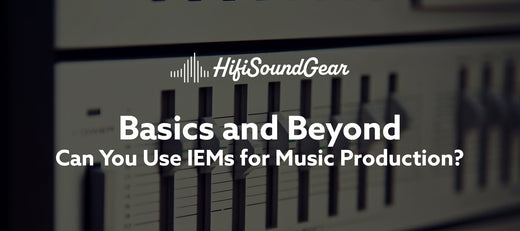
Can You Use IEMs for Music Production?
Let me paint you a familiar scene: It's 2 AM, you're finally in the creative zone, but your neighbors are one bass drop away from staging an intervention. We've all been there! This is where IEMs (In-Ear Monitors) enter the chat as potential studio monitor alternatives.
IEMs have risen in popularity in recent years, but can these tiny ear-dwelling wizards really replace those bulky studio monitors? Dive in and find out!
Understanding IEMs in the Production Context

Let's start with some real talk: IEMs aren't just fancy earbuds with delusions of grandeur. Professional IEMs are precision-engineered tools that can pack serious audio fidelity into a form factor smaller than your favorite guitar pick. At their core, IEMs come in three main flavors:
Balanced Armature (BA) drivers are like the Swiss watch movement of the audio world - precise, detailed, but sometimes lacking in raw bass punch. Think of them as the analytical listeners that can help you spot that slightly out-of-tune high hat in your mix.
Dynamic drivers are the muscle cars of the IEM world. They excel at delivering that visceral bass response that makes producers grin like kids in a candy store. While they might not have the microscopic detail of BA drivers, they often provide a more "natural" sound that can be crucial for long production sessions.
Hybrid setups combine both technologies, like having both a precision scalpel and a sledgehammer in your audio toolkit. These often provide the best of both worlds but come with a price tag to match their sophisticated innards.
Advantages of Using IEMs for Production
The perks of using IEMs for music production are pretty compelling. First off, they're incredibly portable - your entire monitoring setup can fit in your pocket, making hotel room production sessions actually feasible. Try doing that with a pair of 8-inch monitors!
Isolation is another major win. With proper fitting tips, IEMs can provide up to 26dB of isolation, meaning you can focus on your mix without environmental noise coloring your judgment. It's like having a mini recording studio wherever you go.
But perhaps the most underrated advantage is consistency across different environments. Your IEMs will sound the same whether you're producing in a treated studio or a coffee shop (though I wouldn't recommend the latter for critical listening sessions!).
Potential Challenges and Limitations

Now, let's address the elephant in the room - or should I say, the limitations in your ears. Extended IEM use can lead to ear fatigue, and it's crucial to take regular breaks. I recommend the 60/60 rule: no more than 60% volume for 60 minutes at a time.
Bass response can be tricky with IEMs. While some models deliver impressive low end, you're still dealing with physics here. A 10mm driver simply can't move air like a 12-inch subwoofer. This means you'll need to develop a strong reference point for how bass translates between your IEMs and larger systems.
Spatial awareness can also be challenging. Traditional monitors create a natural crossfeed between your ears, while IEMs create a more isolated stereo image. Some producers find this disconcerting at first, but your brain does adapt over time.
Best Practices for IEM Production
Success with IEM production comes down to proper technique and setup.
First, invest in proper measurement and calibration tools. A calibrated microphone setup with acoustic measurement software can help you understand your IEMs' frequency response and adjust accordingly.
Reference tracks are your best friends. Build a playlist of professionally mixed tracks in your genre and listen to them regularly through your IEMs. This helps you develop a mental reference for how good mixes should translate through your setup.
Consider using crossfeed plugins when mixing with IEMs. These can simulate the natural bleeding between ears that occurs with speaker monitoring, potentially leading to better-translating mixes.
Essential Tools and Accessories

Your IEM toolkit should include:
- A quality audio interface with a clean, powerful headphone amp
- Multiple types of ear tips for different applications and comfort levels
- A reliable measurement system for frequency response checking
- A dedicated cleaning kit to maintain optimal performance
Hybrid Monitoring Approaches
The smartest producers I know use a hybrid approach. Use IEMs for detailed work and critical listening, then cross-reference on traditional monitors for the bigger picture. Think of it like painting - sometimes you need to get up close with a fine brush (IEMs), and sometimes you need to step back and look at the whole canvas (monitors).
The Bottom Line
Can you use IEMs for music production? Absolutely yes - with the right approach, proper calibration, and understanding of their strengths and limitations. They're not just viable tools; they're becoming increasingly essential in modern production workflows.
Remember, great music has been produced on far worse monitoring systems. It's not about having the perfect tool - it's about knowing your tools perfectly. Whether you're mixing the next chart-topper or producing beats in your bedroom, IEMs can be a valuable asset in your production arsenal.
Just keep in mind: your ears are your most precious tools. Treat them (and your IEMs) with respect, take regular breaks, and always trust your instincts. Happy producing!
Elevate Your Listening Experience With These Related Articles
Enjoyed this article? Feel free to check out these related topics!

